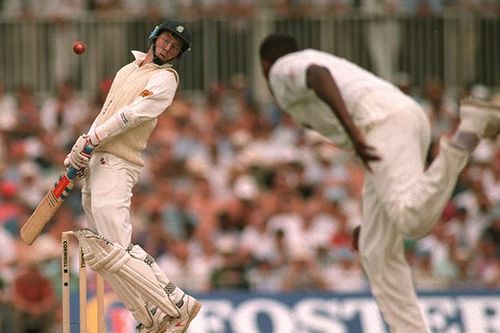
Curtly Ambrose - The bowling machine from Antigua

A batsman on strike would look to do two things. Numero uno – protecting his wicket and two, scoring as many runs as possible. But with Curtly Ambrose 22 yards away, the latter is hardly contemplated as staying alive at the crease in itself is a strenuous task. When this six and half feet tall West Indian bowler delivered the ball from over 10 feet above the ground, the line and length of it, rather than the pace or swing, would leave the batsman awestruck and answerless. Surviving six balls off his unyieldingly accurate bowling would take as much strength and skill as dodging six bullets from a gun. So lethal was his bowling, ever intimidating the opposition. Curtly was merciless and mingy when it came to conceding runs. “The batsmen should not get any free runs. They should have to work just as hard as I have to get a wicket”, he says. Skippers succumbed to his deadly balls so frequently that he was called the ‘weapon of regicide’ by his colleagues. Curtly Ambrose was a bringer of joy to his team but for opponents, he was nothing but a nightmare. Ambrose, who always wanted to be an exceptional basketball player in his childhood, ended his career as one of the greatest fast bowlers the game of cricket had ever seen.
History always has an upper hand over the contemporary in a way that it has no one to adjudge things, making way for creations. Curtly Ambrose belongs to that group of elite creators. He created a style for himself and had an action of his own. Ambrose’s style was so accurate that it would more often than not hit the target. This made Ambrose a bowler who would time and again provide his team breakthroughs in the right situations. Curtly Ambrose made his debut in 1988, following the retirement of Joel Garner, and was readily identified by seniors in the game as the right successor. Later in his career, CEL Ambrose incessantly made unprecedented impressions. Out of the gobs of impressions he scripted in the books of cricket, two stand as his trademarks.
The dangerous spell – seven for one:
30th January, 1993 – Day 1, Second Test, West Indies tour of Australia – must be a very forgettable day for Australians at the WACA stadium as they witnessed what was probably one of the most abject dismissals of the Aussies. Curtly Ambrose delivered a devastating spell that could not have been any more daunting to the opposition. He sent seven of the Australian eleven back to the pavilion, while conceding one run in his first spell, and all seven were out caught. But what could the hapless victims of this ruthless attack do? The ball would rush straight onto the bat, and bounce off it to find its place in the fielder’s hand, not giving any time to the batsmen to decide on their shots. While the top order collapsed, the tailenders managed to extract 24 more runs from this handsome devil in his second spell and the match culminated in the mighty Australians losing by an innings.
Waking the lion – the wristband issue:
Dean Jones (Australian batsman) is infamous for getting himself into controversies. But he might not have known that his entire team was being jeopardized when he got into one with Curtly Ambrose in the first final of the Benson & Hedges World Series Cup, 1992-93. Ambrose already had the openers walk back and was in the middle of a fiery bowling spell. It all began when the umpire asked him to remove his wristband (at Jones’ request). Ambrose was reluctant and found it senseless as he had been using wristbands throughout his career. Although he agreed to removing the band, when his captain asked him to get back into game, he was all the more raged, annoyed and fired. What followed was the downfall of Australian players. He sent down scorchers and avenged the situation with a five wicket haul. Many years later, Ambrose recalled the match and said, “you should never wake a sleeping lion”.
After years of fast bowling, Curtly also had to face the nemesis of speedsters – injuries and aches. This apparently marked the decline of the legend. He started missing a few tours. Even when he returned to playing, Ambrose could not reach his full speed and did not collect as many scalps as he used to. And the bowling machine hung up his boots in 2000, after 12 years of cricket. Ambrose’s cricket life was complete but one thing that got away was the World Cup. He mentions it as the only regret he has.
Aftermath of cricket:
All through his days of cricket, Curtly was a man of few words. Of course! He always made the ball do the talking. But after he retired, the silent assassin slowly started unveiling himself to the world. The ceremony to induct him into the ICC Hall of Fame was quite fortunate to have “Curtly talk to no man” expressing his joy. “I’m quite happy” he said and continued, “I see this also as a just reward for all the joy and happiness that I may have brought to cricket and cricketers alike.” And now he continues giving joy, but in a different way – as a musician.